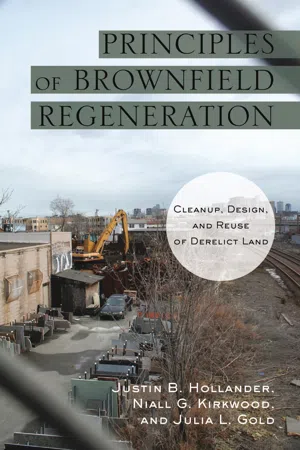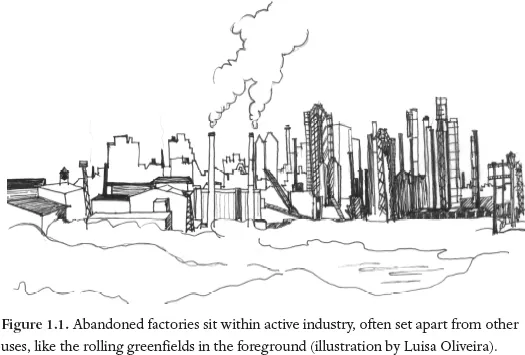![]()
CHAPTER 1
Introduction
For a class of properties that are often contaminated, dilapidated, and dangerous to occupy, brownfields have been remarkably popular in this first part of the twenty-first century. As the world has begun to turn a deep shade of green in practically every arena, from lamp design to air travel, the brownfields concept has taken off like few other ideas in the fields of land use and real estate development.
The term brownfield originated in the early 1990s when practitioners and researchers saw how emerging regulatory frameworks designed to protect the environment were, as a side effect, inhibiting the reuse, cleanup, and redevelopment of former industrial and commercial sites. These brownfield visionaries reconceptualized vacant lots and abandoned properties; they invented a new term, brownfield, to express both the challenges and opportunities that such sites offered.1
The U.S. Environmental Protection Agency defines brownfields as idle real property, the development or improvement of which is impaired by real or perceived contamination.2 It is the contamination (even perceived contamination) that represents the most significant public problem and the greatest barrier to putting idle property back into use. See Box 1.1 for examples of typical brownfield sites.
BOX 1.1
Common Examples of Brownfields
• light-industrial factory sites
• corner gas stations in cities
• dry-cleaning operations and stores
• manufactured gas plants
• metal-plating a factories
• electronics manufacturing
• pharmaceutical plants
• chemical manufacturing
• automobile manufacturing
• tannery factory sites
• utility substations
• textile mills
• oil- tank farms
• shunting yards and rail corridors
• municipal buildings with asbestos insulation
• methamphetamine labs
• graveyards and burial grounds
• remote locations of municipal landfills and decommissioned Department of Defense military reservation land, which house, in addition to many of the industrial uses listed above, specialized conditions of munitions storage, firing ranges, and proving grounds
WHY SHOULD WE CARE ABOUT BROWNFIELDS?
Juxtaposed against the “greenfield”—composed of farmland, forest, or pasturelands that have never seen development—brownfields offer a more sustainable land-development choice. By taking full advantage of existing infrastructure, cleaning up contamination, and leaving greenfields untouched in their virgin states, brownfields take center stage in a sustainable planning strategy of thwarting sprawl, preserving open space, reducing greenhouse-gas emissions, and reinvesting in urbanized areas and their communities. In rapidly urbanizing areas, brownfields—if reused—can host new development and new uses that would otherwise spread throughout undisturbed landscapes far outside urban centers. Brownfields can help balance regional land-development processes, so that fewer virgin greenfields are despoiled and at the same time underutilized land can be regenerated (see Figure 1.1).
Across the fence from boarded-up brownfield sites sit the neighbors, who often suffer from long-term pollution and the stigma effect on property values associated with abandoned property. Reusing these sites brings many benefits to the quality of life in the surrounding neighborhood, such as reduced crime, enhanced local environmental quality, and improved property values.3 If integrated into a broader strategic planning framework, brownfield reuse can address broader societal challenges of improved energy efficiency; reduced consumption of natural resources; cleaner air, water, and land; and an overall reduced carbon footprint. For those living near a brownfield, reuse and redevelopment can be transformational—particularly for those plagued by a legacy of environmental injustice.4
First and foremost, reusing brownfields is good for the property owner, as a successful remediation can go far in limiting an owner’s liabilities at a property. Some owners will “mothball” their brownfields in order to hide from legal and environmental responsibilities, but research has shown that such owners are only making things worse for themselves.5 Working closely with state and federal regulators can increase a property’s real-estate value and allow an owner to leverage that value to address environmental liabilities.
For cities and towns, the broader benefits of brownfields reuse are connected to the economic opportunities presented by restoring environmentally damaged land and eliminating the kinds of blight that scare away new business. For cities like New Bedford, Massachusetts, and Trenton, New Jersey, gaining an international reputation as a place to redevelop brownfields has put them on the map and helped them attract a new cadre of businesses and economic activity into their communities.
Addressing brownfields is a critical piece in a broader set of urban planning strategies that are linking local action with global climate change. Research has shown that development of greenfield sites on the exurban fringe is a key contributor to greenhouse gas emissions, energy use, pollution, and natural-resource consumption.6 Policies that support brownfield reuse effectively reduce barriers to infill development on existing urban lands, thereby relieving development pressure from these greenfield exurban sites. The result is a lighter carbon footprint and a more sustainable pattern of human settlement.
THE CURRENT STATE OF BROWNFIELDS
By most estimates, the number of brownfields is massive—U.S. government estimates put the number of American brownfields at about half a million, and in Asia and Europe the totals may be just as high.7 Brownfields are found in both cities and towns, in the rural hinterland, and the inner suburbs. Brownfields are suspected to be present on nearly every continent of the globe, with the greatest prevalence in post-industrial zones—places where industry boomed in the nineteenth or twentieth century and has since waned. But not all brownfields are the same. They range in size, extent of contamination, and market value. The simplest example, the gas station with leaking underground tanks, is often the easiest to redevelop. On the other side of the spectrum are the skeletons of industrial dinosaurs, the defunct steel mill complexes or abandoned mines that have widespread and unknown contamination and little market value.8 Each class of brownfields demands unique treatments in terms of both remediation and planning (see Figure 1.2).
When the concept of brownfields was born, U.S. federal largesse followed, and over the last fifteen years billions have been spent in combined public/ private investments in characterizing, remediating, and redeveloping brownfields.9 But the billions spent have resulted in a mere modicum of success compared to the sea of derelict sites scattered throughout our cities and towns. More work is certainly needed.
While the challenges to brownfields reuse abound, there is ample evidence that one big challenge is knowledge—knowledge about how to even get started with a site, knowledge about the ways to characterize and remediate sites, and knowledge about reusing brownfields, dealing with regulatory officials, and potential liabilities. In this book, we attempt to satisfy this knowledge gap by offering a brief, concise, and clear primer on the topic of brownfields. We offer sufficient guidance on basic design and remediation techniques to prepare the reader to be an effective partner in a brownfields reuse project. This book will serve as a foundation for the kind of on-the-job learning that occurs in any new and novel enterprise; it will also provide the reader with some vocabulary and equip the reader to ask the right kinds of questions. Case studies are presented at the end of the book so the reader can see how the concepts introduced here have been applied in practice. And finally, extensive notes and bibliography at the back of the book offer the next steps for those who want to do further research. It is our goal that this book will enable professionals, activists, and ordinary citizens to become more engaged in getting their brownfields back into use, and thus to help their own communities navigate a path to a sustainable future.
![]()
CHAPTER 2
Approaching Brownfield Redevelopment
This chapter introduces many of the key factors that are essential to consider when beginning or planning a brownfield redevelopment. By discussing the stakeholders, programs, and technicalities that are important to be aware of, this chapter can serve as a useful starting point when planning for a project. It is vital that each of the issues discussed below is considered carefully and that all the options and available opportunities are understood when getting involved in a brownfield project. It is easy to overlook critical factors when getting started with a site, but the issues that get pushed aside can play a large role in a project’s success.
In approaching this section, the authors considered their own experience working on brownfields and realized that being an expert on a topic can sometime cloud one’s memory of being a novice. To balance our extensive experience, we reached out to a distinct subgroup within the brownfields world: first-timers. These real-estate, planning, and environmental professionals all had significant professional experience but had never faced a brownfields project. Using a “snowball sampling” approach—we first talked to our contacts, and then talked to their contacts—we ended up with a group of 25 people who had fairly recently been involved in their first brownfields project. The group included local officials, architects, citizen activists, real-estate developers, leaders of nonprofits, and business owners. What follows is a distillation of the advice of these first-timers, improved in a few minor ways by the authors’ decades’ worth of experience in brownfields and rearticulated as a simple three-step plan for approaching brownfield development.
WHAT TO BE AWARE OF BEFORE GETTING STARTED
Before beginning with a project, it is important to have a clear plan. This may sound obvious, but sometimes it can be easy to begin site remediation without fully understanding what the end result will look like. Many first-time brownfield developers explain that it is easy to rush projects, especially when funding is time sensitive. These first-timers stressed the importance of not letting time dictate decision making and of ensuring adequate preparation for each step before jumping into a project. By thinking through the process from the beginning, it is easier to see the bigger picture. Although brownfield projects have the tendency to change and thus require flexibility, it is crucial that every project have a story to present. Having a clear picture of where a project is and where it is headed will help to build a solid foundation for its future.
Once a project enters the planning stages, a number of simultaneous questions emerge:
1) Who will be involved? That is, what agencies, members of the project team, and individuals or groups within the community?
2) How will the team’s preliminary plans be communicated to adjacent property owners and to local and state officials, and how will stakeholders’ input be considered in rethinking and redesigning the brownfields reuse strategy?
3) What are the relevant support programs and options for cleanup, liability, insurance, and funding? It is important to remember that every case is unique. The following suggestions can help in navigating the process of cleanup, design, and redevelopment, but in the end each project will create its own path.
BOX 2.1
HYPOTHETICAL TEAM
• Lead developer, company, or organization
• Project manager and assistant
• Local, state, and federal agencies
• Environmental engineer
• Environmental attorney
• Environmental consultant
• Architect
• Landscape architect
• Contractor
• Local community groups and non-profits
OTHERS TO INCLUDE
• Grant providers
• Neighborhood residents
• Owners or residents of adjacent properties
• Local politicians
• Ne...


